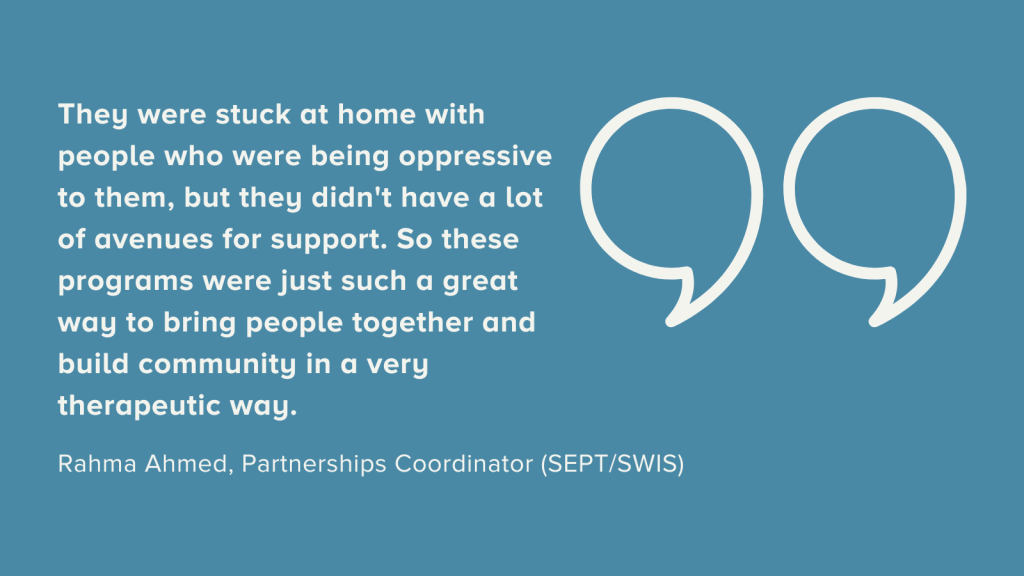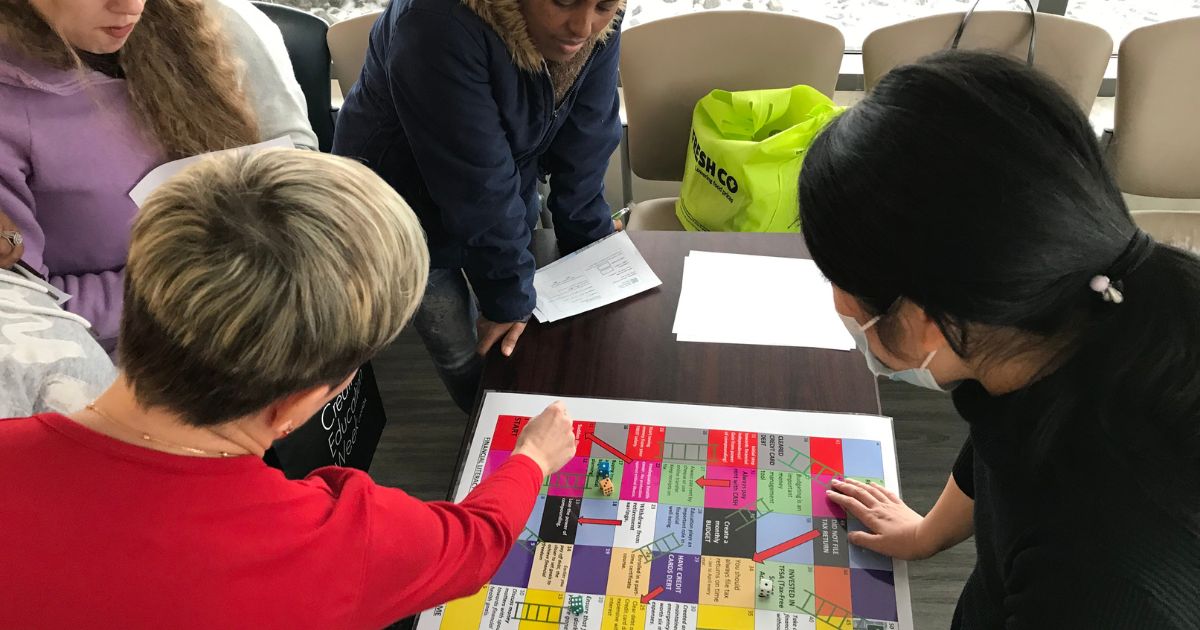News
GBV Programs Break Stigmas and Barriers
Gender-Based Violence (GBV) Programs and Services for women and refugees support safe, happy, and healthy homes, relationships, and communities.

At North York Community House (NYCH), we offer Gender-Based Violence Programs and Services for women and refugees to support safe, happy, and healthy homes, relationships, and communities. GBV staff offer case management, mental health support, legal education, financial support, art workshops, and organize events to raise awareness. GBV programs allow members of the community, predominantly women, to learn more about building healthy relationships, legal rights in Canada, and financial knowledge. They also provide safety tips and connect women with priority housing. Nowshin Choudhury, GBV and SWIS Worker, Rahma Ahmed, Partnerships Coordinator (SEPT/SWIS), and Lucy Santos, GBV and SWIS Worker, are three of the staff involved in the Gender Based Violence (GBV) programs and services at NYCH.
“The program has given us a lot because we feel like we are at home. The support we get here doesn’t have a price,” Judith, a program participant, says.
GBV Art Group and GBV Women’s Circle are two programs at NYCH that focus on education and empowerment. The pandemic exasperated gender-based violence — staff observed an increase in domestic disturbances in the homes of community members. Rahma, who was working with the community at the time, explains, “Statistically, gender-based violence was so much more prevalent during the pandemic, but there wasn’t much help for folks that were experiencing domestic violence or GBV issues. They were stuck at home with people who were being oppressive to them, but they didn’t have a lot of avenues for support. So these programs were just such a great way to bring people together and build community in a very therapeutic way.”
Maria, a group participant, says, “I’m overcome by emotion, happiness, to be accompanied by other people in such a cozy environment. We have a lot of respect and empathy for each other.”
Lourdes, another woman in the program, says she was feeling depressed when she started coming to the group. She was crying a lot and just had a stroke. She explains that Lucy offered care and helped her a lot. “I’m so very happy every month,” she says.
About the Participants
The groups consist mostly of newcomer women in their 30s and 40s, but they also work with women in their 20s, men, and seniors. The participants come from various countries, including Afghanistan, Pakistan, Bangladesh, and Nigeria, and speak many languages, including Farsi, Urdu, Bengali, Spanish, English, and Hindi.
Nowshin offers services in English and Bengali, and Lucy offers services in English and Spanish. They use a hybrid model, with in-person and virtual programming. Since the programs and services are free for permanent residents, convention refugees, and government assisted refugees, most of the participants hold experiences as both women and diasporic people.

Diasporic Women and Larger Societal Issues
Rahma explains, “I often noticed that it wasn’t just their experiences as survivors of violence in the family, but their whole migration journey at different points were violent. It was a total cumulative experience of migrating or forced displacement, from one place to another, integrating into Canada, and how that impacted them. Their experiences as diasporic women was something that was very relevant in conversations with participants, especially with newcomers who were also survivors. With a lot of women, it was breaking cultural barriers of gender roles that are formed at home. And that’s really at the root of so many issues they were facing — not being allowed to work, not having financial autonomy…Those were some of things that we saw very frequently with women, which comes down to patriarchal gender roles at home, kind of like a microcosm of bigger societal issues but happening at home.”

Impact of GBV Groups
With these programs, the team hopes to break the stigma around GBV issues; educate people; increase awareness among newcomers about their rights and responsibilities; and build community.
“The biggest difference I saw was that people felt like they weren’t alone. They felt like they had a community,” Lucy says.
“Today was my first time attending, but I love the group!” Noah, a new member, says. “It makes you get out of the home and you feel relaxed and happy. You can carry that happiness into the rest of your life.”
Lucy explains that making art in the GBV Art Group allowed participants to take their minds off their daily routine and just focus on creating. She says the participants find it soothing to make art and that the art they make is amazing.

“People have a lot of stress at home so the program helps release stress. The participants feel like we can navigate their issues together. Sometimes people just want to be heard, they have no one else to talk to or share their feelings with.”
A group participant says they laugh and do exercises to promote healthy living.
Another major component of the GBV programs and services is teaching the participants how to access services and resources, including Ontario Works and legal aid.
“We’re giving them the tools to navigate the system by themselves,” Nowshin says.
Staff provide information and resources, offer supportive counseling, and empower women to make their own decisions.
“Women might need empowerment in various ways: finding a job, support with their relationship…” Nowshin says.
Lucy explains that any time they can empower a woman to be independent and to protect herself is a success.

A Journey to Safety and Independence
A community member met Nowshin through a friend two years ago. She was having domestic issues at the time and wanted to move out with her then 3-year-old daughter but says she didn’t have any clue which resources were available to her.
“Over the last two years, Nowshin has been very helpful in many ways,” she says. “She guided me every step of the way – about legal aid, how to retain a lawyer, everything,” she says. “She put me in contact with Ziana. I still remember her name. She helped me with housing. I applied for government housing and got it after that.”
The first winter after she moved out, she needed weather appropriate clothing, so Nowshin helped her with that too. She says Nowshin checked up on her every few months to see how things were going with her.
“At the start, I didn’t know much about women’s independence and rights,” she says.
She learned about these concepts in the GBV groups, programs, and workshops, and better understood the financial abuse she was facing and how to address it.
“It was very helpful for me to get that information,” she says.
She had come to Canada from Pakistan in 2019 and says she was sheltered, not getting out much, and unaware of how things worked in her new home.
“I wasn’t used to going out anywhere. I didn’t have much information about things, how things go on, because my ex-husband was doing everything, including our taxes,” she explains.
Since moving out, she got to know her community and became more informed.
“It’s good to know these things! I didn’t know enough before. But learning to do my taxes and the initial programs about the rights of women in Canada helped me gain a lot of knowledge.”

The GBV programs and services, and the staff who deliver them, are an integral part of keeping our communities informed and safe. The participants attend financial literacy workshops, create art, receive counseling, learn about their rights, and the resources and services available to them, and perhaps most of all, they build community and find safety when they need it most.
“I would say, at the end of the day, my heart is in the community,” Lucy says.

Click the link below to learn more or to get involved.

